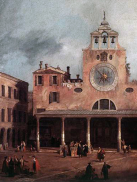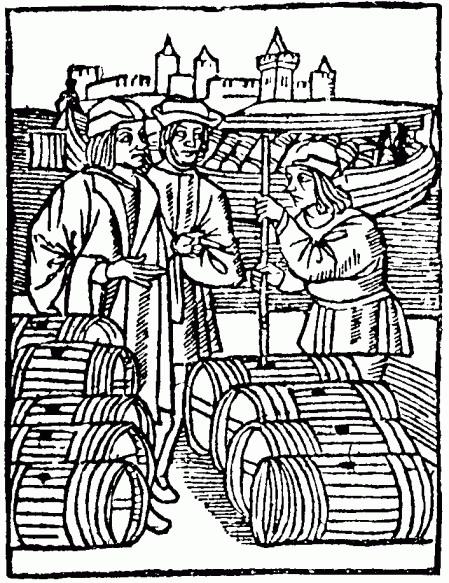January 2, 2013
Mueller, Reinhold C. (1987) I banchi locali a Venezia nel Tardo Medioevo. Studi Storici, 28/1: 145-55.



There is a lot to be admired in Austrian economists, their resilience, their attachment to simple elegant ideas and their sound understanding of the long-term factors that give the economy its cyclical nature. But one must admit that their Ludite-like hatred for finance is to the very least puzzling. They claim to trust nothing but gold and they would like to see the activity of banks restricted to little more than a locker service. Their trust in free market and in the adaptive nature of human ingenuity ends at the door of their local branch of HSBC. Read the rest of this entry »
 1 Comment |
1 Comment |  Economic History, Europe, Middle Ages, reading notes | Tagged: 1200s, 1300s, 1400s, 1500s, Banco del, bank, banking, banks, central banking, finance, Italy, Venice |
Economic History, Europe, Middle Ages, reading notes | Tagged: 1200s, 1300s, 1400s, 1500s, Banco del, bank, banking, banks, central banking, finance, Italy, Venice |  Permalink
Permalink
 Posted by Ben
Posted by Ben
July 15, 2009

"Police officers marching in Urumqi". Photo by Gilles Sabrie for The New York Times
If you want to know more about the historical and economic origins of Uighur’s unrest in China last weeks, here is a good article on Xinjiang’s history by Edward Wong, a New York Times journalist.
 Leave a Comment » |
Leave a Comment » |  Asia, Economic History | Tagged: 1200s, 1300s, 1400s, 1500s, 1600s, 1800s, 1900s, 2000s, China, empire, Ottoman |
Asia, Economic History | Tagged: 1200s, 1300s, 1400s, 1500s, 1600s, 1800s, 1900s, 2000s, China, empire, Ottoman |  Permalink
Permalink
 Posted by Manuel A. Bautista-González
Posted by Manuel A. Bautista-González
March 13, 2009
Gelderblom, Oscar (2005) “The decline of Fairs and Merchant Guilds in the Low Countries, 1250-1650″, Economy and Society in the Low Countries before 1850, Working Paper 1, 47p.



This article is available on line
Between the 11th and 13th century, during the Commercial Revolution, long-distance trade in Europe expanded rapidly thanks to organizational improvements such as fairs and merchant guilds (p.1). In fairs, merchants increased their chance to find business partners and benefited from the protection and the contract-enforcement abilities of the local jurisdictions. Merchant guilds were associations of traders from the same origin present in a foreign market and united in order to increase their bargain power with local authorities (p.2). Read the rest of this entry »
 Leave a Comment » |
Leave a Comment » |  Early Modern, Economic History, Europe, Middle Ages, reading notes | Tagged: 1200s, 1300s, 1400s, 1500s, 1600s, Amsterdam, Antwerp, Belgium, Bruges, fairs, guilds, institutions, merchant community, merchant guilds, merchant networks, merchants, Netherlands |
Early Modern, Economic History, Europe, Middle Ages, reading notes | Tagged: 1200s, 1300s, 1400s, 1500s, 1600s, Amsterdam, Antwerp, Belgium, Bruges, fairs, guilds, institutions, merchant community, merchant guilds, merchant networks, merchants, Netherlands |  Permalink
Permalink
 Posted by Ben
Posted by Ben
January 27, 2009
Bosker Maarten, Buringh Eltjo and van Zanden Jan Luiten (2008) “From Baghdad to London. The dynamics of urban growth in Europe and the Arab world, 800-1800”, CEPR.



Introduction
In this article, the authors wonder how did Europe rose from insignificance to global domination from 800 to 1800, while the relative importance of the neighbouring Muslim regions decreased. They try to define the “preconditions for the genesis of the modern economic growth” (p.3) and to understand the roots of the European modernity. When did Europe and the Arab world diverge (p.4).? Read the rest of this entry »
 5 Comments |
5 Comments |  Africa, Asia, Early Modern, Economic History, Europe, Middle Ages, reading notes | Tagged: 1000s, 1100s, 1200s, 1300s, 1400s, 1500s, 1600s, 1700s, 1800s, 800s, 900s, Arab World, cities, economic development, Great Divergence, institutions, urban growth, urbanization |
Africa, Asia, Early Modern, Economic History, Europe, Middle Ages, reading notes | Tagged: 1000s, 1100s, 1200s, 1300s, 1400s, 1500s, 1600s, 1700s, 1800s, 800s, 900s, Arab World, cities, economic development, Great Divergence, institutions, urban growth, urbanization |  Permalink
Permalink
 Posted by Ben
Posted by Ben
January 15, 2009
Joseph Shatzmiller (1990) Shylock reconsidered: Jews, Moneylending, and Medieval Society, Berkeley, University of California Press, 250p.*

Introduction
From February to July 1317, a trial opposing a Jewish moneylender called Bondavin to his client Laurent Girard took place in Marseille. Bondavin accused Laurent of not having paid back a 60-sols loan (15). A significant sum, but nothing extraordinary compared to Bondavin own’s fortune (certainly several hundred pounds) (21). So why did Bondavin engaged in a procedure if not for money? Read the rest of this entry »
 Leave a Comment » |
Leave a Comment » |  Economic History, Europe, Middle Ages, reading notes | Tagged: 1200s, 1300s, 1400s, banking, Credit, France, Jewish, Jews, Loans, Marseille |
Economic History, Europe, Middle Ages, reading notes | Tagged: 1200s, 1300s, 1400s, banking, Credit, France, Jewish, Jews, Loans, Marseille |  Permalink
Permalink
 Posted by Ben
Posted by Ben
August 31, 2008
Durand Robert (2004) “L’or musulman et la formation du Royaume du Portugal” in Michaud Françoise (ed.) Les Relations des pays d’Islam avec le monde latin du milieu du Xe siècle au milieu du XIIIe siècle, Paris, Vuibert, 250-261.


Introduction
In the early 20th century, M. Lombard proposed the following thesis: the Muslim expansion triggered a major de-hoarding movement of the Sassanid and Byzantine gold reserve held in the newly conquered territories. According to R. Durand, a rather similar event may have followed the Almoravid and Almohad conquests of Spain. And it may have had a significant impact upon the formation of the Portuguese kingdom (p.250). Read the rest of this entry »
 Leave a Comment » |
Leave a Comment » |  Economic History, Europe, Middle Ages, reading notes | Tagged: 1000s, 1100s, 1200s, Al-Andalus, Almohads, Islam, money, Portugal, state-making |
Economic History, Europe, Middle Ages, reading notes | Tagged: 1000s, 1100s, 1200s, Al-Andalus, Almohads, Islam, money, Portugal, state-making |  Permalink
Permalink
 Posted by Ben
Posted by Ben
July 6, 2008
Arnoux Mathieu (2001) “Innovation technique et genèse de l’entreprise. Quelques réflexions à partir de l’exemple de la métallurgie européenne (XIIIe-XVIe siècles)”, Histoire, économie & société, 20/4, 447-454.


This article is available online!
Introduction
Metallurgy and the related industries have been significant players in the economic development of 12th- and 13th-century Europe. All over the period metal consumption increased significantly. The producers met the demand by finding ways of increasing their productivity. Hydraulic energy was used to hammer larger pieces of iron and steel and then to ventilate furnaces (448). The new process was further developed in Belgium (the so-called Walloon process) and spread all over Europe in 1450-1550. Read the rest of this entry »
 Leave a Comment » |
Leave a Comment » |  Early Modern, Economic History, Europe, Middle Ages, reading notes | Tagged: 1200s, 1300s, 1400s, 1500s, industry, innovation, metallurgy, proto-industry |
Early Modern, Economic History, Europe, Middle Ages, reading notes | Tagged: 1200s, 1300s, 1400s, 1500s, industry, innovation, metallurgy, proto-industry |  Permalink
Permalink
 Posted by Ben
Posted by Ben
April 6, 2008
Epstein Stephen R. (2000) “The late medieval crisis as “integration crisis’” in idem Freedom and Growth. The rise of states and markets in Europe, 1300-1750, New York/London: Routledge/LSE, 38-72.



Introduction
The post-war historians thought ‘traditional societies’ did not experienced growth in per caput income due to the lack of technological innovation. But recent research has shown they could be much more productive then formerly thought, so pre-modern societies operated well below their potential: technology was not a fundamental constraint. In agriculture, only a handful of regions were reaching their technological frontier: Essex, Flanders, Lombardy, etc. Elsewhere, the bulk of the medieval innovations was still to be introduced (38). Commercial progress also allowed specialisation to take place, but warfare regularly reversed these improvements (39). Read the rest of this entry »
 Leave a Comment » |
Leave a Comment » |  Economic History, Europe, Middle Ages, reading notes | Tagged: 1200s, 1300s, 1400s, 14th century crisis, Black Death, crisis, deflation, England, feudal economy, France, Great Famine, Malthus, market integration, plague, Ricardo, Smithian growth, state-making |
Economic History, Europe, Middle Ages, reading notes | Tagged: 1200s, 1300s, 1400s, 14th century crisis, Black Death, crisis, deflation, England, feudal economy, France, Great Famine, Malthus, market integration, plague, Ricardo, Smithian growth, state-making |  Permalink
Permalink
 Posted by Ben
Posted by Ben
February 24, 2008
KELLY Morgan (1997) “The Dynamics of Smithian Growth”, The Quarterly Journal of Economics, 112/3, 939-964.



Smithian progress (i.e. the understanding that specialization causes output to rise first articulated by Adam Smith) is neglected by economists because it is perceived as gradual (unlike the sudden growth caused by innovation, learning by doing and private capital accumulation). But the author dismisses the idea that Smithian growth is necessarily gradual. Read the rest of this entry »
 Leave a Comment » |
Leave a Comment » |  Asia, Economic History, Middle Ages, reading notes | Tagged: 1000s, 1100, 1200s, 800s, 900s, China, Smithian growth, theory |
Asia, Economic History, Middle Ages, reading notes | Tagged: 1000s, 1100, 1200s, 800s, 900s, China, Smithian growth, theory |  Permalink
Permalink
 Posted by Ben
Posted by Ben
January 27, 2008
Britnell Richard H. (2001) “Specialization of work in England, 1100-1300”, Economic History Review, 54/1, 1-16.



Introduction
The 12th and 13th centuries experienced growing population. The more people, the more likely it is that some will become specialized in an activity where they enjoy a comparative advantage (see Adam Smith). Persson has estimated that this led to a 0.1 to 0.25 yearly increase of productivity per caput in England over two centuries (i.e. between 22 and 62% for the whole period). But to what extend the period’s productivity gains are attributable to specialization? Read the rest of this entry »
 Leave a Comment » |
Leave a Comment » |  Economic History, Europe, Middle Ages, reading notes | Tagged: 1100s, 1200s, 1300s, city, development, England, growth, guilds, labour, proto-industry, Smithian growth, specialisation, urban economy |
Economic History, Europe, Middle Ages, reading notes | Tagged: 1100s, 1200s, 1300s, city, development, England, growth, guilds, labour, proto-industry, Smithian growth, specialisation, urban economy |  Permalink
Permalink
 Posted by Ben
Posted by Ben
October 14, 2007
Jacques Le Goff (1986) La Bourse et la vie. Economie et religion au Moyen Age, Paris, Hachette, 150p.*



Introduction
After the council of Lateran IV (1215) confessions became private and regular instead of rare and collective. The individual became responsible of his own sins instead of assuming his share of the sins of the whole society. Pawnbrokers are thus suddenly singled out by the church as symbol of cupidity at a time when the central quality put forward by the Church was poverty. Read the rest of this entry »
 10 Comments |
10 Comments |  Economic History, Europe, Middle Ages, reading notes | Tagged: 1200s, 1300s, bankers, banking, banks, capitalism, money, religion, usury |
Economic History, Europe, Middle Ages, reading notes | Tagged: 1200s, 1300s, bankers, banking, banks, capitalism, money, religion, usury |  Permalink
Permalink
 Posted by Ben
Posted by Ben






 Posted by Ben
Posted by Ben 






















